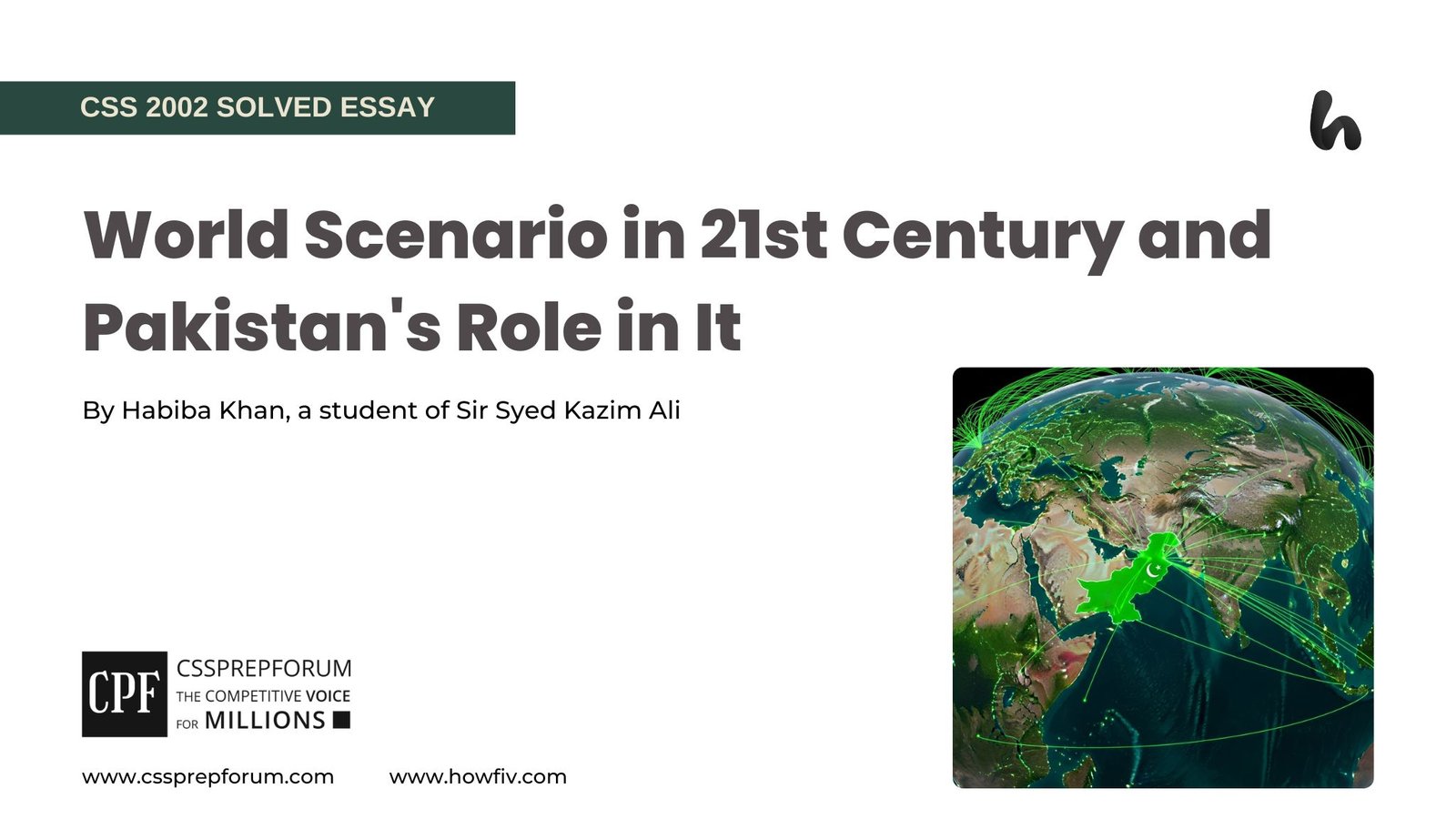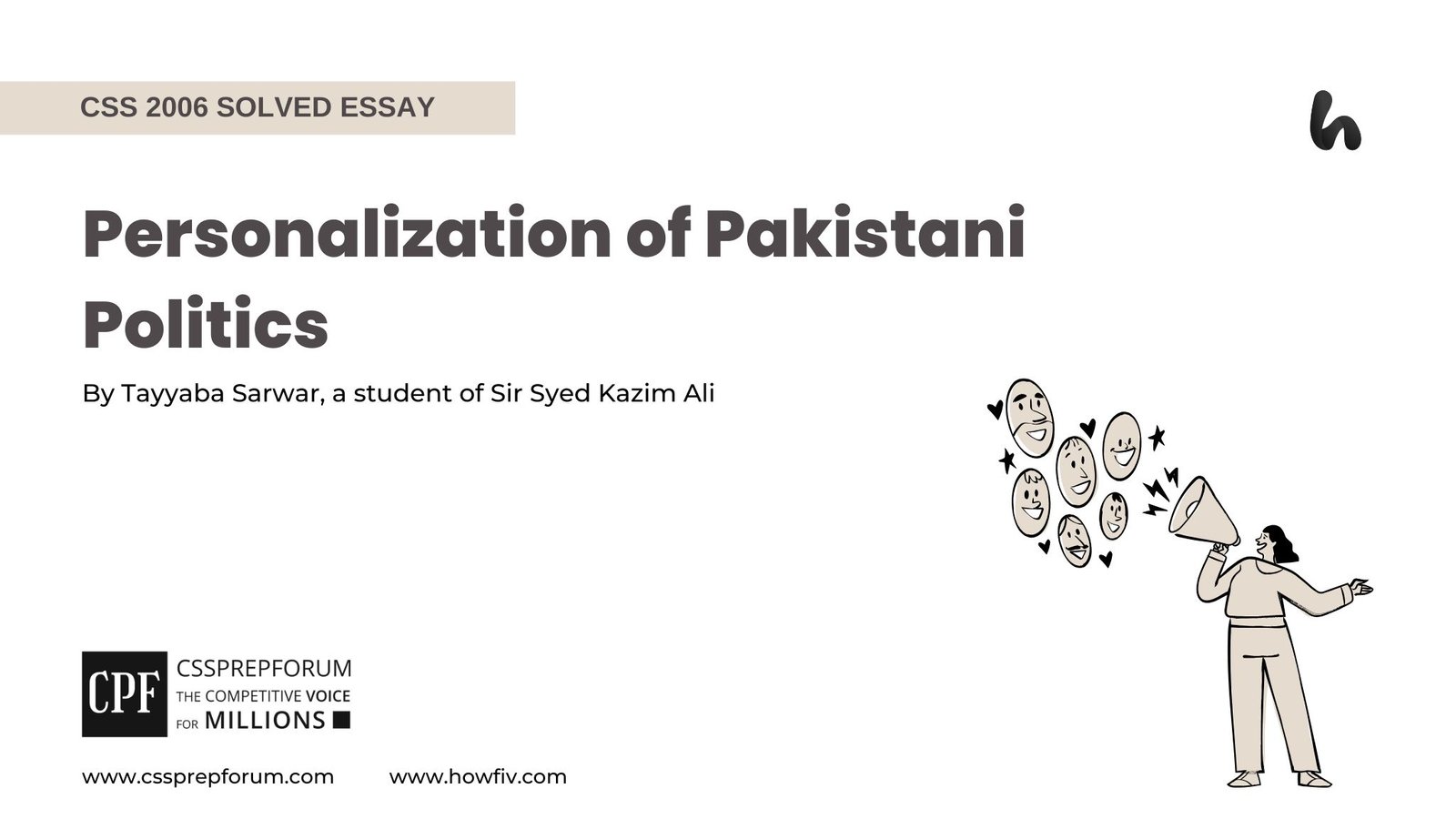CSS 2009 Solved Current Affairs Past Papers | The Strength of Chinese Economy as a Threat to USA
The following question of CSS Current Affairs 2009 is solved by Sir Ammar Hashmi, the best Current Affairs Coach, on the guided pattern of Sir Syed Kazim Ali, which he taught to his students, scoring the highest marks in compulsory subjects for years. This solved past paper question is uploaded to help aspirants understand how to crack a topic or question, write relevantly, what coherence is, and how to include and connect ideas, opinions, and suggestions to score the maximum.

Question breakdown
This question has one part, i.e., the changes that America requires at the Policy Level for harmonious relations with China.
Outline
1-Introduction
2-China’s Growing Economy and Global Influence
3-Perception of China as a Threat to U.S. Hegemony
- ✓ Growing Economic Influence Challenging U.S. Trade Dominance
- ✓ Technological Advancements as a Challenge to U.S. Leadership
- ✓ Global Diplomatic Influence Through Multilateral Organizations
4-Policy Changes Required by the US for Harmonious Relations with China
- ✓Rebalance Trade Relations through Fair Agreements
- ✓ Promote Diplomatic Engagement via Strategic Dialogues
- ✓ Focus on Regional Alliances and Partnerships
- ✓ Encourage Technological and Economic Collaboration
- ✓ Support Global Governance Reforms
- ✓ Address Human Rights Concerns through Diplomatic Channels
5-Critical Analysis
6-Conclusion

Introduction
Given China’s historical economic growth, it has emerged as a significant competitor in the global economy, surpassing the United States. China’s growing economy, marked by volume growth in its economy, technology, and its assertiveness in various global organizations, has been seen or perceived as a rising superpower challenging America’s supremacy in trade, technology, diplomacy and everything in between. The United States is therefore worried about this development, especially given that China has gradually positioned itself as a global economic and diplomatic power that interferes in regions the United States previously controlled. Consequently, to cover its diplomatic interests in these states, this analysis concludes that the United States, it seems, would have to accommodate this new multiple-pole system to provide good relations with them enumerated the following enhancements: trade relations and cooperation that adapt to unfair competitive shifts, diplomacy that is characterized by frequent communication, and counterparts in the region. Besides acknowledging synergy in technology and the economy, enabling policies in global arrangements and the diplomatic recognition of human rights on a worldwide scale could positively redefine the relationship between the U.S. and China. Ideally, such policy changes are expected to protect the privileges of the United States and its relationship with China because, in the growing global interconnection, it is crucial to have a win-win approach.
China’s Growing Economy and Global Influence
Over the years, China has been among the fastest and most successful growing countries, elevating it from a third-world to a first-world economy. There is Chinese economic power growth based on industrialization, an export-oriented economy, and more foreign direct investment inflows, which creates new economic zones and has the trend of globalization in the context of political and economic relations with another country, the Belt and Road Initiative. This economic influence applies to technology, such as telecommunication and renewable energy sectors, where China has displaced old-world companies. Moreover, China has paid more attention to multilateralism, including participating in the United Nations and World Trade Organization. Thus, it proves that China wants to be part of the global norm makers, and efficient cooperation with the Chinese on one side and being threatened by the Chinese on the other is essential for the USA.
Perception of China as a Threat to U.S. Hegemony
- ✓ Growing Economic Influence Challenging U.S. Trade Dominance
The continued economic growth of China has made the country one of the global players in trade, displacing the United States. Thanks to enormous trade volumes, facility construction, and partnerships with world countries, China has firmly established itself in emerging markets. This has enabled China to secure resources, open export destinations, and create relationships that put trade on an entirely new trajectory, leaving the earlier model that the United States dominated. This is because as the economic connectivity of China increases, it displaces the US in matters to do with trade, thus raising concerns about the effect of this on export destiny and competitiveness of the American economy.
- ✓ Technological Advancements as a Challenge to U.S. Leadership
Besides the significant economic advancement, China has also developed increased technological prowess in several areas, like telecommunication, artificial intelligence, and renewable energy. Chinese companies – some backed by state funding – have acquired a significant market presence in the leading sectors and directly confront America’s premier companies. Some technologies, such as 5G, are susceptible areas of technology within the Chinese technological domain that present both an economic challenge and a security risk to the United States of America. It has occasioned a view that China’s capacities could one day outcompete American innovation, thus eroding this country’s dominance in the tech world.
- ✓ Global Diplomatic Influence Through Multilateral Organizations
Apart from the technological advancement, China’s increasing engagement with mechanisms in multilateralism supports the understanding that it is learning how to manage its strategic antagonistic role versus the United States. China has enhanced its diplomatic influence by joining international bodies such as the UN and WTO, especially in third-world countries. This diplomatic overture enables the emergent international order that China wants, of which the New Silk Road is a part, to replace the one the United States prefers and does not suit the Chinese strategic calculus. The analysis of the interests of contemporary China based on its participation in multilateral organizations and the focus on the Win-Win diplomacy question the American hegemonic model of the international system and the formation of the multipolar world.
Policy Changes Required by the U.S. for Harmonious Relations with China
- ✓ Rebalance Trade Relations through Fair Agreements
To reduce tensions and enhance healthier economic relationships for mutual benefit, the United States could concentrate on changing trade relations with China to more reasonable terms that would address issues related to a trade imbalance, rights on intellectual property, and market access. At the same time, tariffs or sanctions damage relations; a friendly policy and the desire to obtain stupendous trade advantages can enhance collaboration. Through reasonable accommodation between the two partners, the two countries could safeguard their competitive stakes in the bilateral economic relations and map out the basic framework of relations that would last for some time.
- ✓ Promote Diplomatic Engagement via Strategic Dialogues
Continuous exchange of information would ensure that the U.S. has an opportunity to confront China on issues of concern without allowing misinterpretations to enhance the conflict. Regularised discussions on security, technology, and economic relations could be conducted as talks aimed at creating specified channels of communication through which misunderstandings could be resolved, common interests could be identified, and mutual mistrust could be alleviated through cooperation on shared problems such as climate change, regional conflict, and trade.
- ✓ Focus on Regional Alliances and Partnerships
The US could avoid directly confronting China by forging stronger bonds with Asian countries, such as Japan, South Korea, and ASEAN. Preserving and enhancing American power with cooperative security and economic engagement, deterring aggression, and promoting economic stability in the Asia-Pacific makes cooperation best suited for a constructive engagement strategy.
- ✓ Encourage Technological and Economic Collaboration
To avoid the competition becoming hostile, the US might search for cooperation zones of interest with China, for example, in such spheres as environmental technologies or medical and power-saving industries. Supportive partnerships should help build reciprocally beneficial economic and scientific ties to show that the US-China relationship could positively alter the world. It also helps to defuse tensions in issues likely to cause conflict where there appears to be intense competition in the development of technologies.
- ✓ Support Global Governance Reforms
The U.S. could support reform of global governance institutions, leveraging its capacity to work in concert with China and others to strengthen the inclusivity and effectiveness of institutions such as the United Nations, the International Monetary Fund, and the World Trade Organization, not only in addressing specific challenges but also in facilitating the kinds of cross-boundary collaborations and interactions of which it can now stand to benefit most. Support for reforms that allow these organizations to respond more sensitively to today’s global trends can produce a U.S. commitment to multilateral cooperation and a balanced order abroad in which both countries would play constructive roles.
- ✓ Address Human Rights Concerns through Diplomatic Channels
Though there are delicate bones in the U.S.-China human rights dealings, the U.S. might set out with these conversations to negotiate progress without annoying China. Unilateral sanctions need to communicate the U.S.’s values. They can do more damage to the relationship than dialogue about human rights. Dialogue about human rights unites the existing relationships of the defence partnership and allows the U.S. to express its voice. This permits the expression of concerns that do not generate conflict and keeps communication open for work on other aspects.
Critical analysis
To critically analyse, the U.S. approach to China management is based on nuances of balance between competition and cooperation in the policy. Fair agreement and balance in trade relations can be the practical basis of stability, but that would entail genuine reciprocity from China. At the same time, economic imbalances and intellectual property concerns, though still need to be solved, will likely cloud trust if unresolved. Strategic dialogues to address mutual concerns present a vital form of diplomatic engagement that does not require immediate adversarial measures. Within the divergent ideologies and national interests that the ideologies and national interests of each country entail, it is scarcely possible to maintain open communication channels. In addition, long military alliances can help the U.S. achieve strategic leverage. However, China may need to use it more effectively as a containment that unnecessarily heightens tensions and makes cooperation opportunities scarce. Technological and economic collaboration is encouraging but needs broad safeguards to protect U.S. innovation and security while both nations compete for technological dominance in some critical fields. In areas such as environmental technology and healthcare, the two sides could greatly benefit from a cooperative understanding, a positive side of U.S.-China relations. However, there is mutual mistrust of sensitive technology. Inclusivity and international institutions’ effectiveness could be improved by supporting reforms in global governance—but these reforms would also push the U.S.’s traditional influence in these bodies to the limits of adaptability to a more multipolar leader. Addressing human rights concerns presents another complex dilemma: The U.S., though, is committed to its democratic values and might not be able to launch overt criticisms of China’s internal policies, which could fuel resentment and impede the broader diplomatic progress. Therefore, by following this pattern of respectful dialogue, the USA can achieve its principles and strategic goals simultaneously. They also have a difficult path forward, a new recalibration of U.S. priorities and recognition of China’s accepted place in the emerging global order. The most innovative way to balance strategic competition and constructive cooperation will result in the best opportunity for a stable, mutually beneficial relationship. But that will require patience on one side, some strategic foresight, and compromising from both.
Conclusion
To conclude, the untrodden trajectory to economic development followed by China has become a significant threat to America’s superior hegemony in the international systems. Nevertheless, the two countries must get into overdrive to refashion their politicking to support this improved, mutually beneficial relationship. By providing adequate economic partnership, adopting diplomacy to fix candid communication, and consolidating susceptible policy in regional security relationships, America can ensure its strategic aims as the world shifts to new powers. There could be a positive sum game between the technology and economic sectors to generate benefits that make both sectors highly dependent on each other, thus not generating conflicts. Promoting change in governance structures for the world and willingly responding to the Global Human Rights Bureau’s concerns also demonstrates the U.S. regard for a stable and more evenly composed international system. Finally, these policy shifts are less about balancing with China than reconstructing a healthy and positive relationship between the U.S. and China. To sum up, strategic diplomacy would help promote long-term stability for both countries and the global society because the balance between competition and cooperation is critical in today’s global village.

CSS Solved Past Papers’ Essays
Looking for the last ten years of CSS and PMS Solved Essays and want to know how Sir Kazim’s students write and score the highest marks in the essays’ papers? Then, click on the CSS Solved Essays to start reading them.
CSS Solved Essays
CSS Solved General Science & Ability Past Papers
Want to read the last ten years’ General Science & Ability Solved Past Papers to learn how to attempt them and to score high? Let’s click on the link below to read them all freely. All past papers have been solved by Pakistan’s top CSS GSA coach having the highest score of their students.
General Science & Ability Solved Past Papers












